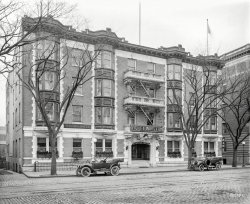
MAY CONTAIN NUTS

Search Shorpy
SHORPY ART

Framed or unframed, desk size to sofa size, printed by us in Arizona and Alabama since 2007. Explore now.
Join and Share
Ad-Free Shorpy
Shorpy is funded by you. Patreon contributors get an ad-free experience.
Learn more.

Recent comments
- There is an interesting novel set here.
- I Was In Berlin
- Pronunciation
- Shell of a Shell
- Never been there but
- BUR-lin
- Hand-made smokes
- Birthplace of Tupperware, or at least its inventor
- Pulp
- Remarkably unchanged in 84 years
- The church is still there ...
- Talk about a smoke show
- Electric Hansom Cab
- I wondered the same thing.
- The location in 2009
- Pill Pusher
- Roll your own
- Rugged and real!
- Civil War history
- Early EV?
- A Charles Purcell - Mama Cass Connection
- Uncle SAAM
- Obfuscation
- One Chocolate Soldier rode away
- Victor Marquis de la Roche
- The Little House Across Way ...
- Vanderbilt Gates
- Vanderbilt Mansion
- You can still see that gate
- Withering heights for me
Member Photos
The Shorpy
Printporium
Printporium
Search Shorpy
Search results -- 30 results per page
- Super Chief: 1943
- ... at least 3 grand old railroad lines, the Harvey House hotel (upper left behind the station) was torn down, and the beautiful Mission ... across the street from the Harvey House in some old, cheap hotel.
You can get back to me, if you wish, at majskyking@gmail.com
... Posted by Dave - 07/29/2024 - 9:58pm -
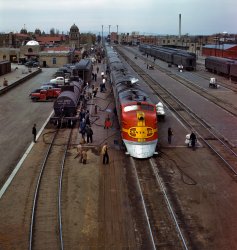
- Savannarama: 1915
- ... of Savannah, Johnson Square, Savannah Bank Building and Hotel Savannah." 5x7 inch dry plate glass negative, Detroit Publishing Company. ... as it may be, wreaks havoc with navigation.
The hotel was nothing extraordinary, perhaps, but made the April 1913 ... Posted by Dave - 09/11/2024 - 5:48pm -

- Grand Central: 1900
- New York circa 1900. "Grand Central Station and Hotel Manhattan." The coming decade would see the replacement of this structure ... Posted by Dave - 09/10/2024 - 3:21pm -
![Grand Central: 1900 New York circa 1900. "Grand Central Station and Hotel Manhattan." The coming decade would see the replacement of this structure by the current Grand Central Terminal. 8x10 inch glass negative, Detroit Photographic Company. View full size.
The eagles of Grand CentralA search for Grand Central Eagles yields interesting stories.
The couple who found one in their back yard.
And the story of one that ended up Upstate.
Poor Grand Central Station only lasted 12 years: from 1898 to 1910.
Electric TrolleyIt's surprising to see electric trolleys and horse-drawn trolleys sharing the same set of tracks, but also surprising to see an electric trolley with no overhead wires -- how did it pick up the electricity?
[Through the slot between the rails. - Dave]
A streetcar named electricThe last of Manhattan's cable cars were converted to electric power around 1901. The car draws its current via a "shoe" that extends down through the slot seen running between the tracks. Same system used by electric streetcars in Washington, D.C., many examples of which can be seen on these pages:
Cable car?I'd be pretty confident saying this is a "cable car." The Metropolitan Street Railway operated cable trolleys.
http://www.cable-car-guy.com/html/ccnynj.html#msry
San Francisco wasn't the only place that had them.
[In 1898 the Metropolitan Street Railway began converting its cable traction lines to underground electric power. - Dave]
Eagle on the ballIt is speculated the that eagle below the dome ended up in Essex, NJ at the Space Farms Zoo and Museum.
http://outdoors.webshots.com/photo/1113715013034126691DiLhTm
Greg
American ExpressWikipedia tells me AmEx started as an express mail and shipping operation. What do you think this wagon's delivering, and to whom?
White Wing!The man lower right in the white suit and pith helmet is a "White Wing." These were the first street cleaners in New York.
Lone HorsemanThis is the first urban horse & carriage era Shorpy picture in which I recall seeing a (civilian) man on horseback, rather than drawn in a wagon or carriage (he's right above the streetcar). Maybe I wasn't paying enough attention, though!!
I wonder if he ever took his horse up to Central Park for a lively canter.
Broncs to BikesUrban horseback riders at the turn of the last century were regarded in a similar way to how we view motorcyclists today; traveling light, moving fast, a bit intimidating (ex: mounted police), a little daredevilish & somehow just a touch less civilized. I mean, you never see the very Edwardian Sherlock Holmes mount a horse except in an emergency.
In many ways, today's bikers have adopted the horseman's accoutrements and lingo: leather chaps, buckskin and fringe, saddles and saddlebags, triple-trees, trick riding, trail runs, etc.
"I'm a Cowboy, on a Steel Horse I Ride!" - Bon (yech) Jovi
Sharing the tracksIn the lower right, under the American Express horse, are the remains of the railroad tracks crossing the horse car track. They joined the trolley track on Fourth Avenue or Park Avenue South, as shown in other Shorpy photos. Even after the 1st Grand Central was built about 1873 and steam locomotives were banned from the streets of lower Manhattan, the New York, New Haven & Hartford RR still insisted on using horses to pull its passenger cars farther downtown over these tracks.
(The Gallery, DPC, Horses, NYC, Railroads, Streetcars)](https://www.shorpy.com/files/images/4a07322a.thumbnail.jpg)
- Hotel Netherland: 1913
- New York circa 1913. "Hotel Netherland, Fifth Avenue." 8x10 inch dry plate glass negative, Detroit ... they tore it down. Its successor, the Sherry-Netherland Hotel, opened in 1927.
William H. Hume, architect WILLIAM H. HUME, ... in New York, among them the Emigrant Savings Bank, Hotel Netherland (built 1892), Hebrew Orphan Asylum, Scotch Presbyterian ... Posted by Dave - 07/18/2012 - 3:38pm -
![Hotel Netherland: 1913 New York circa 1913. "Hotel Netherland, Fifth Avenue." 8x10 inch dry plate glass negative, Detroit Publishing Company. View full size.
Double-DeckersWhen I was growing up in the 50's my mother used to tell me about the open-top double-decker buses on Fifth Avenue that she remembered from her childhood. This picture would be taken about ten years before she was born, but they were still using those buses (or some very much like them) in the 20's and 30's. Long gone by the 1950's, alas.
Ward's "Tip Top" Bread...was a staple in our house back in the 1940's. The bread wrapper featured a field of 5-pointed stars on a dark field at either end. It was as good as any, and possibly better than some, such as the competing Silvercup, Bond, Sunbeam, Holsum and other brands sold in the NY Metro area.
ImpressiveNow THAT is a building.
Panic in the StreetsI wonder what the drivers of the horse-drawn vehicles thought during that year? Were they bitter, anxious, worried about their living?
When you look at Shorpy street scenes of say, 1910, the ratio of autos to horse-driven vehicles is reversed; here only a scant three years later, only a half-dozen or so horse carriages can be seen. How quickly the era of the horse faded!
Oh, and that electric delivery wagon is really cool. Thanks for another great one.
What a Great Design!I love the way the round turret just kind of grows out of the truncated corner!
From the NetherlandsThat building is indeed the most beautiful thing I've seen. And I'm not saying that because I was born in the Netherlands.
Aural HistoryWouldn't you love to hear the sounds emanating from this scene?
Ward's BreadTheir vehicle (I hesitate to call it something more specific) looks like a like a horse-drawn wagon, but where's the horse? Could this thing have been converted to self-propulsion?
[It's an electric delivery wagon. Note the battery box. - Dave]
No two alikeWow, what a facade. No two storeys alike. On a 16-storey building, I count 11 cornice lines. "Exuberant" hardly begins to cover it. And then of course in the 1920s they tore it down. Its successor, the Sherry-Netherland Hotel, opened in 1927.
William H. Hume, architectWILLIAM H. HUME, architect, died in New York, November 11, 1899, aged sixty-five. He designed many important buildings in New York, among them the Emigrant Savings Bank, Hotel Netherland (built 1892), Hebrew Orphan Asylum, Scotch Presbyterian Church, and Colonial Clubhouse.
Wow!Such amazingly clear focus and wealth of detail in these old photographs. They are indeed a time machine allowing us to see back to an exact moment and place from the past frozen for us to view forever. A chapter in a book could not convey all that is captured in this photograph!
And suddenly, trafficWhat a difference seven years makes. The wide-open streets of 1906 are now thronged with automobiles, although parking is still easy.
Hotel RobberyIn those days, stealing architectural styles was good. And, of course stealing from multiple sources was even better. But, don't get me wrong -- I just love this over-the-top stuff. Good taste is so boring!
(The Gallery, Cars, Trucks, Buses, DPC, NYC)](https://www.shorpy.com/files/images/4a21138a.thumbnail.jpg)
- In My Room: 1941
- June 1941. "Untitled (Hotel room, Milwaukee, Wisconsin)." Medium format acetate negative by John ... all these give a feeling of the time and place.
The Hotel Wisconsin A July 5, 1941 letter to Vachon from FSA's Roy Stryker indicates Vachon was staying in the Hotel Wisconsin on this visit. That 500-room hotel, constructed in downtown ... Posted by Dave - 02/26/2020 - 8:01pm -
![In My Room: 1941 June 1941. "Untitled (Hotel room, Milwaukee, Wisconsin)." Medium format acetate negative by John Vachon for the Farm Security Administration. View full size.
The everyday worldI like some of these photos by Vachon - no drama. no pathos, no unusual point to be made, just a document showing how things were and what they were. The "stick" telephone, the sink, the style of furniture, all these give a feeling of the time and place.
The Hotel WisconsinA July 5, 1941 letter to Vachon from FSA's Roy Stryker indicates Vachon was staying in the Hotel Wisconsin on this visit. That 500-room hotel, constructed in downtown Milwaukee in 1913, survives today as a renovated apartment building.
Chicken wireIs that what was used for a screen? Can't imagine it would keep too many insects out!
[Zero chickens here, so it must work. - Dave]
That ashtrayDAMN that's a big ashtray. I assume that's what the flat glass object on the dresser is.
High-capacity, perhaps, as a safety measure, to reduce the frequency with which it would be dumped into the trash, with the attendant fire risk?
Signs of the TimesI love the placement of the faucet spout. So high up the wall. It would be great for washing your hair. Although the splashing from so high up could be messy.
With his wallet out and so close to the pillow, do you think this could have been for police evidence? Taken just after his room was broken into?
And a soon to be a vanishing relic from the past. The telephone book. It was such a basic necessity back in the day. Now you can hardly find one.
Dang I love this site. Thanks guys.
Welcome to the Hotel WisconsinLooks like John Vachon is staying at the Hotel Wisconsin, which is now the Grand Wisconsin Apartments. The view is looking east toward Waldheim's Furniture, and that building also still exists.
ChickenwireThe chickenwire was embedded in the glass to prevent it from shattering. Used to be quite common.
Re: Chicken wireI think that is that kind of glass they used to have in old schools that had wire embedded in it to keep it from shattering.
re: Chicken WireLooks like a kind of safety glass. It had 'chicken wire' embedded in it. My grade school had this in all the ground floor windows and doors.
Nothing missingSteam heat, operable window with shade and drapes, dresser with mirror, ashtray the size of a wading pool, comfy bed, Ameche with directory, nightstand with lamp, sink for morning wash & brush-up, mystery ellipse on floor under sink, wallpaper that won't keep you up at night. Wisconsin was a home game for the Gideons, so that is certainly covered also.
All you could expect of a downtown hotel room in 1941. I'm guessing that it's about a $5 room.
700 Block of North Plankinton AvenueI don't think the hotel is still there, but the building across the street still is. It is the old Waldheim's Furniture Building. Now loft condos.
https://www.wisconsinhistory.org/Records/Image/IM47664
https://www.corleyrealestate.com/idx/listings/river-front-lofts/
Where's the Beer?I guess some things are best kept out of sight.
re: Chicken WireThe wire mesh glass is more fire-resistant than regular glass (but less tough). And Shorpyites know all about hotels and fires...
(The Gallery, Cars, Trucks, Buses, John Vachon, Milwaukee)](https://www.shorpy.com/files/images/SHORPY-8c19667a.thumbnail.jpg)
- Hotel Meade: 1942
- April 1942. "Bannack, Montana. Old hotel." The supposedly haunted Hotel Meade . Medium format acetate negative by John Vachon for the Farm ... town, while Bannack was rated "pure").
Restored The Hotel Meade has since been restored and was recently used in the 2017 movie ... Posted by Dave - 02/17/2022 - 11:20am -
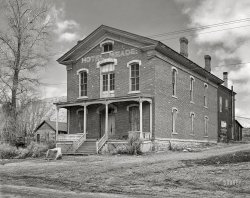
- Hotel Rochester: 1908
- Rochester, New York, circa 1908. "Hotel Rochester, Main Street and Plymouth Avenue." 8x10 inch glass negative, ... Company. View full size.
Mostly Gone While the hotel is gone, the building mostly hidden behind it with the steep roof still ... the mansard roof, just barely visible to the left to the Hotel Rochester, is the Rochester Free Academy. It still stands, but has long ... Posted by Dave - 08/14/2012 - 11:42am -
![Hotel Rochester: 1908 Rochester, New York, circa 1908. "Hotel Rochester, Main Street and Plymouth Avenue." 8x10 inch glass negative, Detroit Publishing Company. View full size.
Mostly GoneWhile the hotel is gone, the building mostly hidden behind it with the steep roof still stands.
View Larger Map
1907 - 1999"300 all outside rooms" that rented for $1.50 a night. Later it was turned into a dorm for RIT, but it was torn down in 1999.
Mostly goneAnd even the old building that still stands is in disrepair.
Curved RoofDoes anyone have any idea what the building at the next corner, to the left, was? That roof area looks like glass panels, an enclosed garden room, perhaps. It is gone, I think, the "slanty" roof building is still there, as noted, but I don't think they were connected. Interesting.
Curved Roof Bldg.The building with the odd curved roof is the Rochester Savings Bank, built in 1844 and described by one writer as a "fancy wedding cake." It was at the SW corner of West Main & Fitzhugh Streets. Just beyond it (almost at the left edge of the photo) on the SE corner of the same intersection is the Monroe County Building, completed around 1894 and still standing. The building with the mansard roof, just barely visible to the left to the Hotel Rochester, is the Rochester Free Academy. It still stands, but has long ceased to serve as an educational institution.
The once grand Hotel Rochester building was imploded on the Saturday before Christmas, 1999; hundreds of onlookers witnessed the event.
ThanksThe beauty of Shorpy! Thanks, Chip. Still curious about that upper floor where the glass is [or appears to be].
National TheatreDoes anyone know anything about the National Theatre next door? I can't find any references to it.
(The Gallery, DPC, Rochester)](https://www.shorpy.com/files/images/4a18810a.thumbnail.jpg)
- Hotel Tuller: 1980s
- A circa 1980s look at the Tuller Hotel, seen earlier here and here . "Tuller Hotel, 501-521 Park Boulevard. The Tuller Hotel was one of the largest luxury hotels in Detroit in the early twentieth ... Posted by Dave - 09/14/2011 - 5:01pm -
![Hotel Tuller: 1980s A circa 1980s look at the Tuller Hotel, seen earlier here and here. "Tuller Hotel, 501-521 Park Boulevard. The Tuller Hotel was one of the largest luxury hotels in Detroit in the early twentieth century, with 800 rooms, each with a private bath. It was also the first hotel built in Detroit's Grand Circus Park district. Lew Whiting Tuller (1869-1957), who erected and operated this hotel, was a major builder of hotels and apartment houses in Detroit in the 1900s and 1910s. The three distinct buildings share a common Italian Renaissance styling." Photograph and caption by the Historic American Buildings Survey. View full size.
Mayor Coleman Young EraA more apt description would be that this is the Detroit of the Coleman Young era.
If anyone is interested in seeing the difference between the vacant properties of Detroit against the border of affluent Grosse Pointe, look no further than the satellite photo of Google maps and the Alter Road divider to see an infill landscape (GP) versus plenty of land (Det) where thousands of homes stood less than 20 years ago.
This is the area where Charlton Heston and my father grew up (although neither knew of the other).
You've heard of the Honeymoon SuiteThis must be the Homewrecker Suite.
Afterparty Is this after Charlie Sheen stayed there?
AlmostToo sad for words. I was looking earlier this evening at a series of pictures showing how some of the great buildings in Detroit have fallen into neglect and disarray. A great shame.
Liberalism's Great SocietyLiberalism's Great Society in actual practice, and what they intend to do to our entire country, if we don't stop them.
[This is Reagan-era Detroit, a city whose decline does not have much to do with "liberalism," or politics in general. - Dave]
Downward Spiral Just heard on NPR yesterday how Detroit's population has fallen from a high of 2 million to around 700,000 today. While I knew Detroit was in a bad way I had no idea the depth of its despair. Hard to believe the "Motor City" of my youth in the 50s and 60s has lost its prominence. How quickly it has faded.
I thinkthe Who must have stayed here. And thank you, Dave, for the nippage in the bud of political nonsense. There's already too much snarkery in the world. Shorpy is above all that.
Hold up there, CowboyRadical Liberalism began in the 1960s hippie movement in SanFrancisco while Reagan was still a cowboy riding his pinto across the make believe range. Radical Liberalism's rampant runaway across America is alive and well and great cities in this country are all on the decline because of it. This hotel room is repeated all over America. it's not political, it's a fact.
[Factwise, when the hippies were grooving to the Summer of Love in San Francisco, Ronald Reagan was governor of California. In 2010, Detroit is depopulating as the auto industry there declines. More people would link the export of manufacturing to the free-trade policies of conservative administrations than to any kind of "liberalism." What would really be interesting (or entertaining) would be to lay out the specifics of how "liberalism" is responsible for the condition of this hotel room. As for it being "repeated all over America," the number of ancient abandoned highrise hotels in this country is probably close to zero. - Dave]
I base my comments more on what I see happening in middle america where rampant extremist liberalism deposited its payload, not so much on THIS hotel room in THIS city. Point about Reagan whether he was riding the range or not, is HE had nothing to do with this hotel room. Where do you live? An Ivory Tower, no doubt where you do not have to mingle with the masses. If you are going to let in one political comment then, speaking from a liberal viewpoint, Shorpy will Also cease to exist. [Roll eyes] Interesting comment from the guy making his political statement commending you for not allowing a political statement. [Roll eyes] You run a good site here, but people are hungry in America, keep your nose clean and give us something to enjoy. [nice of you to allow me this conversation--be nice to continue it in person as so much is lost in text]
[Next up on Fox: "Politically Incoherent." - Dave]
Factwise, there have been some good comments, and some who understand the point I was making. You just aren't one of them, Dave. I had thought you to be a smart guy and now I realize you are just a smart-ass guy. I bet you have a small penis, too.
Current Detroit PhotosColor photos of Detroit's sadder side can be seen here:
http://www.marchandmeffre.com/index.html
The Tuller isn't part of the set but others show the loss of what Detroit had been.
Here Comes The Political MessWhy is it some people just have to share their political opinions with you? Please go where they care about your political opinion; you see I could not care less about your political views. Now if you have photos to share you have my attention.
A common cycleMany a respectable hotel has gone through a cycle of decline. This is not a new thing. As fashions move on, the rising cost of redecorating to stay high-end or even respectable, at some point, intersects with falling revenues. Buildings obsolesce, become more costly to maintain, leaving less money for services. Clientele becomes more and more down-market, until the building finally succumbs to decades of neglect. Sometimes, after a decade or so of dereliction, the establishment finds new owners and new capital, and rebounds. The Tuller was not so lucky. As we have seen, some folks are just itching to blame this cycle on '60s liberalism (cue eye-roll), but this cycle played itself out many times before that decade.
PoliticsI think there were some politicians of all types who contributed to the decline of Detroit, most prominently in the mayor's office. That said, Shorpy is a much better place when it is nonpartisan.
Damn Hippies Killed the TullerSorry, I just couldn't help the title. The image came first. The room just creeped me out.
YIKES!Looks like they kept the "DO NOT DISTURB" sign out to long.
I was hereI was one of the architectural team that evaluated the condition of the hotel just before it was demolished, and the seeds of its decline were sown back in the 20's and 30's, and are not the result of liberalism, Reaganomics, or anything more complicated than the poor decisions of the owners. The additions to the hotel, especially the one on Washington Boulevard side, were poorly planned and poorly executed - you had to go outside across a metal fire escape just to get from one side of the hotel to the other! The original hotel could never have been called elegant, and its decor over the years just got worse until a 1950's remodel made it look up to the minute in 1954, but terribly dated by 1960. Every other major hotel in Detroit, the Statler, the Hilton, the Cadillac, the Fort-Shelby, was ruined by 'modernizations' in the 50's, 60's and 70's that replaced or covered the original elegance and classic details in favor of ersatz 'luxury' that faded quickly. The thing that killed them ALL, however, was the opening on the Westin in the Renaissance Center in the early 1970's. How could any old, drafty, non-air conditioned hotel with its rattly elevators, cracked plaster, peeling paint and knocking radiators compete with a 2000 room glass and concrete symbol of the future? Both the Cadillac and the Fort Shelby have been renovated and re-opened, both required complete gutting and both required conversion of half of the building to condos, just to pay the bills. Now these are the hot new properties, and the Westin looks tatty. The Tuller WAS too far gone to save, its fate was sealed in the 1950s.
The '67 riots sealed Detroit's fateIn addition to the usual business cycle of fancy old hotels losing favor to newer "better" hotels, the city of Detroit received a huge black eye 15 to 20 years prior to this photo.
"White flight" was in full swing by the time of the 1967 riot in Detroit. After the riots, the prosperous black population wanted to move out of the city too. The result was the affluent property and business owners moved to the suburbs. Without a reason for wealthy hotel patrons to visit the city why would there be a need for a luxury hotel in the city?
Idiot's delightNobody has pointed out that the Republican party chose to hold its 1980 convention and nominate Ronald Reagan in Detroit. The idea was to showcase the problem city--AND to promise that things would be different. With 30 years' perspective, we can draw conclusions about both of those notions.
The Tiresome Discussion About DetroitWhy must every discussion of my hometown devolve into either tirades about the evils of "liberalism," or none-too-subtle allusions to race (the "Coleman Young wrecked the paradise that was Detroit" angle), or some nasty combination of the two? But oh-so-little consideration seems to be given to the underlying economic structural factors and technological tides that have been much more historically important in making it both the great boom town of the early 20th century and the poster child of urban dissolution in more recent decades.
Jeez o peteI think that the decline of big cities has less to do with the tidal flows of two-party politics, and more to do with the invention that made Detroit what it was, the automobile... and the mass migration of everybody with money out of those cities. Not to mention poor city planning of the 50s-60s that slashed many urban neighborhoods into pieces with freeways. Cities have only begun to recover in the past decade. In any case, I find it difficult to see how hippies are to blame, especially not for our present and future problems considering that generation is nearly in its 70s.
(The Gallery, Detroit Photos, HABS)](https://www.shorpy.com/files/images/339513pu.thumbnail.jpg)
- Hotel Astor: 1916
- The Hotel Astor on Times Square circa 1916. Note roof garden and, at lower right, ... Posted by Dave - 09/07/2011 - 9:16pm -
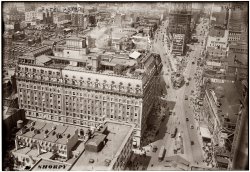
- Hotel Vincent: 1905
- Saginaw, Michigan, circa 1905. "Hotel Vincent." Try our depot shuttle. 8x10 inch dry plate glass negative, ... that (according to the maps and city records) that this hotel stood on the corner of Washington and Germania Avenues. I'm assuming that ... sentiment during WWI.
Map showing where the Hotel Vincent Once Stood marked as "1.".
Fire escapes Do those fire ... Posted by Dave - 08/14/2012 - 2:10pm -
![Hotel Vincent: 1905 Saginaw, Michigan, circa 1905. "Hotel Vincent." Try our depot shuttle. 8x10 inch dry plate glass negative, Detroit Publishing Company. View full size.
Washington and GermaniaIt appears that (according to the maps and city records) that this hotel stood on the corner of Washington and Germania Avenues. I'm assuming that Germania was changed to Federal due to anti-German sentiment during WWI.
Map showing where the Hotel Vincent Once Stood marked as "1.".
Fire escapesDo those fire escapes have access from a hall, or do you have to break into someone's room to get to one? Given the size of the building, the number of fire escapes reminds me of the lifeboat count on the Titanic.
A Fun Afternoon InvestigationFrom History of Saginaw County we see that the Hotel Vincent was on the corner of Washington and Germania.
Google Maps doesn't show a Germania Street in Saginaw. According to Saginaw: Labor & Leisure it was changed in WWI to Federal Street.
So at the corners of Federal and Washington we see today on Google Maps the remnants of a little building to the right of the Vincent Hotel with the three windows on the third floor. From that, here's what the corner looks like today.
View Larger Map
Re: Fire EscapesAlong with the possible other problems, that last step is a doozy!
French Dry CleaningI thought at first the sign, middle-left, said "French Fry Cleaning" But what the heck is French Dry Cleaning?
[Dry cleaning, or "French dry cleaning," as it was called, is cleaning without water. - Dave]
(The Gallery, DPC)](https://www.shorpy.com/files/images/4a22436a.thumbnail.jpg)
- One Second Fast: 1943
- ... like they belong in some fine residence or the lobby of a hotel somewhere. Not the least bit industrial in design! I shudder to think ... Posted by Dave - 07/29/2024 - 9:58pm -
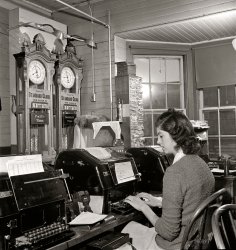
- Chop Suey Canyon: 1916
- ... but an ugly parking lot these days. As for the Charlevoix Hotel, it's still there, but it's been empty since the mid '80s. The Charlevoix was intended to be an office building. Instead, it was a hotel at first but only for about 10 years. It also spent a short time as an ... Posted by Dave - 07/24/2012 - 9:56pm -
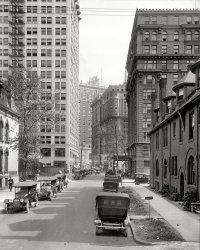
- Hotel Velvet: 1904
- Old Orchard, Maine, circa 1904. "Alberta and Velvet hotels." 8x10 inch dry plate glass negative, Detroit Publishing Company. View full size.
Watching the train roll by As youngsters we would watch the freight trains roll through this cr ... Posted by Dave - 08/14/2012 - 11:15am -
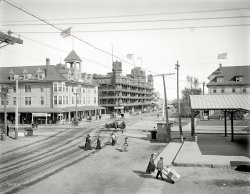
- Hotel Ste. Claire: 1906
- Detroit circa 1906. " Hotel Ste. Claire , Randolph and Monroe streets." Completed 1893, razed in the ... the other 2.
A Bit Changed Today While the hotel is gone a few others down the block are still there. The building next to ... Kratz and Mittenthal.
Flag Poles Why does the hotel have 4 flagpoles near the top? is that to display banners?
... Posted by Dave - 02/27/2016 - 9:30am -
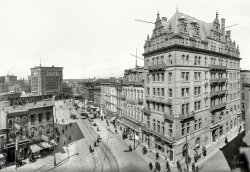
- The New Raleigh: 1912
- ... 1912. "The New Raleigh." The recently completed Raleigh Hotel at Pennsylvania Avenue and 12th Street N.W., built on the site of the previous Raleigh Hotel. 8x10 inch dry plate glass negative, Detroit Publishing Company. View ... Posted by Dave - 09/04/2024 - 4:13pm -

- Hotel Vermont: 1911
- Burlington, Vermont, circa 1911. "Hotel Vermont." Last glimpsed here . 8x10 inch dry plate glass negative, ... a memory of reading one of those signs on the back of a hotel-room door, and seeing "mileage books" as one of the things you were supposed to deposit in the hotel safe instead of keep in your room.
I'm still not quite sure why ... Posted by Dave - 07/27/2018 - 10:06am -
![Hotel Vermont: 1911 Burlington, Vermont, circa 1911. "Hotel Vermont." Last glimpsed here. 8x10 inch dry plate glass negative, Detroit Publishing Company. View full size.
Gift cards, 100 years ago.To the left of the Western Union sign, a small sign that says "Mileages bought and sold" caught my eye. A little research reveals this phrase appearing in newspapers and photos from around 1900 to 1915. I couldn't find a definite explanation, but based on the context of some of those ads, I think it was possible, at that time, to buy a certain number of miles on a particular railroad - sort of like buying a gift card today.
["Mileages" were the coupons in mileage books, which allowed X miles' worth of "interline" travel over multiple railroads. Below, an excerpt from "The Modern Railroad" (1911), and an example of an interline mileage exchange ticket stub. Selling the remaining coupons to a broker before they expire lets the holder avoid a loss on his unused miles. - Dave]
In addition to the railroad selling its tickets there are also railroad passenger traffic organizations, half a dozen or more important ones across the country, which are engaged in selling various forms of railroad transportation. In some cases this takes the shape of a mileage-book which may be honored by fifteen or twenty different lines. The book will perhaps be sold for $25 and will permit of 1,000 miles’ riding at a saving over local fares, if the purchaser comply with its provisions. If he has complied with its provisions within the year’s life of the book, he will be paid $5 rebate upon return of its cover which has given him his riding at two cents a mile. Sometimes these books take the form of “scrip” which is silent upon mileage but which has its strip divided into five-cent portions, sold at wholesale, as it were, at a fraction less than five cents each.
Edit, 31 July 2018: Today I learned, thanks! This also jogged a memory of reading one of those signs on the back of a hotel-room door, and seeing "mileage books" as one of the things you were supposed to deposit in the hotel safe instead of keep in your room.
I'm still not quite sure why mileage books aren't mentioned much in publications after about 1915. I did find a law in New York State, still on the books, that requires railroads with fares between 2 and 3 cents per mile to issue mileage books for no more than 2 cents per mile. Maybe as fares went up, the laws weren't updated, and therefore the railroads were no longer obligated to issue mileage books.
Hotel Vermont? Not with a bit of imagination.I do believe that to be Rick's Cafe with Sidney Greenstreet (Ferrari), wearing his fez hat and just crossing the street to enter as everything magically turns into Vichy-Casablanca of December 1941. Waiting inside, in addition to Rick, are Victor Lazo, Ilsa, Sam, Capt. Renault, Major Strasser and the lovable Carl (Cuddles Sakall). After all, everybody comes to Rick's, though not always for long as Peter (Ugarte) Lorre has already been eliminated.
Academic CoincidenceThe Bowling Academy at left is where Lewis Hine, the man who made Shorpy famous, photographed two pin boys whose work kept them up late on school nights.
http://www.loc.gov/pictures/resource/nclc.03374/
[Coming soon to a website near you! - Dave]
https://www.shorpy.com/node/23650
Loved the awnings back then!Still there! Went to a Brazilian Restaurant on the ground floor a few years back.
(The Gallery, DPC, Horses)](https://www.shorpy.com/files/images/SHORPY-4a25372a.thumbnail.jpg)
- Banff Springs Hotel: 1905
- ... Canada, circa 1905. "Mount Rundle and the Banff Springs Hotel." Nineteenth-century Canadian Pacific Railway resort that gradually ... the mountains, supposedly pointing out where he wanted the hotel, but we long term CPR employees always figured it was his "Hey, you, I ... Posted by Dave - 07/09/2014 - 12:16pm -
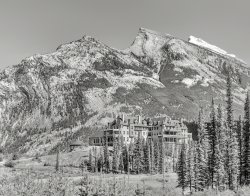
- You Are Here: 1950
- ... Main Street in Friendship, Wisconsin, at the Friendship Hotel, is the answer, supplied by "lifelong Wisconsin resident" Wiscojim. ...
Friendship Hotel The porch still exists on the front of the old Friendship Hotel in Friendship, Wisconsin.
Thanks wiscojim! Now someone help ... Posted by Dave - 09/06/2015 - 5:18pm -
![You Are Here: 1950 UPDATE: Main Street in Friendship, Wisconsin, at the Friendship Hotel, is the answer, supplied by "lifelong Wisconsin resident" Wiscojim. Clapclapclap!
Who can tell us where these old-timers are, other than on a porch near a mountain? 4x5 negative from the News Archive. View full size.
Waukegan, IllinoisThere was a Hoban & Sons Hardware in Waukegan. Jack and William Hoban were two names I turned up as having owned it in the 1910s.
That's all I can find. Anyone with any knowledge of the area think that "mountain" is feasible that close to the lake?
DeLavalNo one who milked cows as a child, as I did, will fail to recognize DeLaval. Together with a company called Surge, they had a duopoly--or close to it--on the milking machine market. It looks as if Karo Syrup is also in the advertising game, just below the hardware folks.
Hogan and Son(s)How about Hogan and Son(s) Hardware, agents for De Laval (farming and dairy machinery).
Friendship, WisconsinThis is Route 13 (Main Street) in Friendship, Wisconsin. Very distinctive view of the north end of "downtown". Many of the original buildings have survived.
Milking machine?http://www.alfalaval.com/about-us/our-company/history-of-alfa-laval/
Friendship HotelThe porch still exists on the front of the old Friendship Hotel in Friendship, Wisconsin.
Thanks wiscojim!Now someone help decipher the black sign on the right side of the street. Looks like SC??? Might mean anything, but I'm pretty sure the bottom two words are "on tap" which would imply a beer brand.
[Here's a slightly different version. -tterrace]
Smoking joyI love the smiles on these old boys' faces, made more subtle by the fact that one has a cigarette holder and the other a pipe in his mouth. No scolding grandchildren, no hotel staff asking them kindly to step away from the entrances, nothing to pollute the unalloyed joy of a simple smoke.
Grand Prizeto the winner of the location, I bet myself there would not be an answer to this particular location (not much to go on here), but foiled again by astute Shorpy fans.
Digit countThis picture reminds me of my uncles. Mom had 9 brothers raised on a farm in Manitoba. Not one made it off the farm with all his fingers intact. Looks like the fella on the left might have had the same fate.
Thanks WiscojimIt made me glad to see that this quiet street of businesses remains relatively unchanged all these 65 years later. That can be said about so little of my own San Diego, CA, where land values are astronomical.
Sleepy Town. The fact that the two gentlemen would sooner pose under a plank of wood that is definitely about to fall off and hit them rather than pull the plank off and then pose tells me just how slow the pace of things must be in a small town like that. There's something admirable about the relaxed attitude of a couple of men who know that they have already paid their dues in life and they can simply leave it to the next guy. That's how I want to be when I retire.
Friendship HotelLovely postcard circa 1912 which shows the second story verandah in all its glory. Found here.
(The Gallery, News Photo Archive, Small Towns)](https://www.shorpy.com/files/images/SHORPY-642.thumbnail.jpg)
- The Hillman: 1906
- Birmingham, Alabama, circa 1906. "Hotel Hillman." Our second look at this inviting inn . 8x10 inch glass negative, Detroit Publishing Co. View full size.
Hotel H One has to wonder if there are two separate basements underneath the wings of the hotel. A bizarre union of onomatopoeia and pareidolia, or the human mind's ... Posted by Dave - 08/21/2012 - 12:00pm -
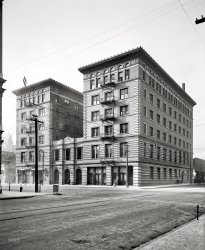
- The Grotto: 1908
- ... New York, circa 1908. "The Grotto, Fort William Henry Hotel." 8x10 inch dry plate glass negative, Detroit Publishing Company. View ... 5 cent cigar!
An Adirondack tradition - the summer hotel The long tradition of large resort hotels has pretty much passed. In ... Posted by Dave - 07/30/2011 - 9:01am -
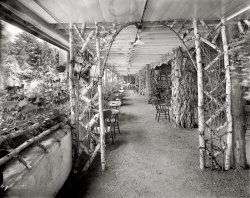
- Ghost Convention: 1909
- June 1909. Toledo, Ohio. "The lobby, Hotel Secor." I cackled with glee upon realizing that this empty-looking time exposure was in fact crowded with spectral hotel guests. Are they still there? 8x10 inch glass negative. View full size. ... has been "modernized" since the building is no longer a hotel. I hate to imagine that beautiful skylight is no longer visible.
... Posted by Dave - 07/29/2012 - 6:14pm -
![Ghost Convention: 1909 June 1909. Toledo, Ohio. "The lobby, Hotel Secor." I cackled with glee upon realizing that this empty-looking time exposure was in fact crowded with spectral hotel guests. Are they still there? 8x10 inch glass negative. View full size.
Why haunt with these stuffed shades?I could be joy riding out to Calvary Cemetery in that streetcar on the previous photo, or heading down to the waterfront to look for that nifty little Toledo and Ohio Central switch engine we saw a few weeks back.
And since this is 1909, the tort lawyers haven't caused everyone to be so uptight; maybe I could get a cab ride with the train crew!
I Wonder if the photographer was using this as technique to empty out the lobby or if the extremely long exposure was the only way to shoot a large interior space with the equipment at the time.
Cackled?Ha! It's interesting that the photographer didn't have to clear the space to get a fairly people-free view of this wonderful lobby. What worries me most, though, is how the space has been "modernized" since the building is no longer a hotel. I hate to imagine that beautiful skylight is no longer visible.
"Anybody see a ghost?"Dave, why would they need such a long exposure, I thought the plates were a lot faster by 1908. Also, was the original very washed out?
[The commenter below speculates that a long time exposure may have been used to "empty out the lobby." This does seem to be the case, if the finished product -- a chrome postcard -- is any indication (click to enlarge). As for the original being washed out, the "original" is a negative -- for what we're looking at, there is no print. The positive reference image is obtained by "inverting" the negative; its appearance depends a lot on the equipment and settings used to image the plate. The goal is to extract maximum information in both shadows and highlights. Below we see the negative and the inverted positive that I used as the starting point for the Shorpy image. - Dave]
Hotel CaliforniaYou can never leave. Heck you will never WANT to leave with all the comfy chairs and complimentary newspapers.
How Long ?Any guess on just how long a time exposure would have to be to render a bunch of mostly very sedentary (some almost apparently snoozing) gents as "ghosts"? Most other examples seem to have been when folks were more animated and strolling about. Too bad there isn't a large-handed clock in the view to give a clue.
Hey!Who moved my spittoon?
Spitting ImagesI believe that the cuspidors in the photograph buttress my theory of this being the first appearance in literature of Ghosts that could spit.
Spittoon CityThere are at least 10 spittoons visible in this lobby, which says something about the clientele and the times. It would be interesting to see if the Plaza Hotel in New York City provided spittoons in 1909. If it did, it would probably refer to them as cuspidors!
The man who wasn't thereI need to run (I have places to go and people to see) and don't have time to do my research, but in elementary school we had a strange teacher who used to recite the poem similar to the following (paraphrased):
"Yesterday upon the stair, I met a man who wasn't there.
He wasn't there again today, oh how I wish he'd go away."
(It definitely scared me as a third grader).
They're real ghostsThey have to be -- nobody's walking, they're just sitting there. Spooky.
[A time exposure this long (probably measured in minutes, from the look of things) might not show anything that's not fairly motionless for at least several seconds -- it would register standers (of which there is one, toward the rear) and sitters more than walkers. (Theoretically at least, the sitters could all be the same person.) As we know from the many examples of "ghost pedestrians" on these pages, the telltales of walkers in a time exposure are wavy trails for head and torso, and "centipede legs" for footfalls; there's no evidence of that here, so we might conclude that this was a fairly sedentary bunch. On the other hand, you can make the case that, if the sitters had been seated for the duration of the exposure (i.e., not walking to or from their chairs), they would have registered more substantially. My hunch is that this was such a long exposure (ten minutes or half an hour, say) that any walking around would not leave any traces, and that the ghostliest sitters were seated for less than half the duration of the exposure. - Dave]
Is this seat taken?Be advised: the potential for inadvertent lap-sitting is unusually high at the Hotel Secor. Recline with caution.
Ptui.I really feel sorry for the hotel personnel who had to clean those spittoons!
What about now?Would love to know if all the architectural elements are still in place in the lobby today.
Hotel TelcoFrom the Toledo Blade:
After the old Hotel Secor closed in 1969, the building housed Ohio Bell Telephone Co., which tore out much of the original interior of marble columns and decorative plaster, and covered marble flooring with office carpeting by affixing harsh, damaging glue, Mr. Zaleski said.
With the Secor's best features long gone, Mr. Zaleski went about remodeling the ground floor and a few upper levels by stripping the building to its core, exposing concrete-encased walls and structural beams for a raw industrial look. The work was inexpensive to do, and the decor worked fine for his tenant mix of artists, media creators, and Internet start-ups. It also shortened the time he had to wait for the building to generate positive cash flow, he said.
(The Gallery, DPC, Toledo)](https://www.shorpy.com/files/images/SHORPY_4a23286a.thumbnail.jpg)
- Petroleum Palace: 1928
- ... 1928. "Buick sedan at Texaco service station. Jack Tar Hotel site." Now all long gone. 5x7 glass negative by Christopher Helin. View ... of the running board below the driver's door?
Jack Tar Hotel Story on its demolition .
These were called "kick plates." ... Posted by Dave - 01/23/2015 - 12:45pm -
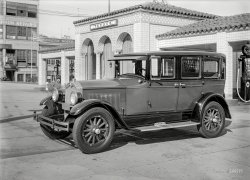
- There's a Tall Hotel: 1905
- New York, 1905. "Hotel Netherland, Fifth Avenue and 59th Street." 8x10 inch dry plate glass ... full size.
At at Lower Height "There's a Small Hotel" was from 1936 Rodgers and Hart musical "On Your Toes" -- which us lucky ... more sense historically, and touted as the world's tallest hotel. The 'New' was dropped in 1908. Demolished in 1927 and promptly rebuilt ... Posted by Dave - 07/14/2023 - 2:26pm -
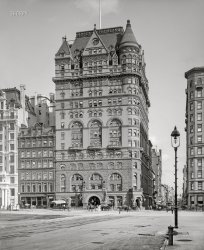
- Sorry, Full: 1953
- ... Full Even the donkey lot is full.
Any Idea What Hotel That Is? It looks like one of those pictured in the many early 1900's shots of Atlantic City we see here on Shorpy.
The hotel I would say it is definitely the Traymore.
(ShorpyBlog, Member ... Posted by Born Too Late - 06/08/2013 - 6:37pm -
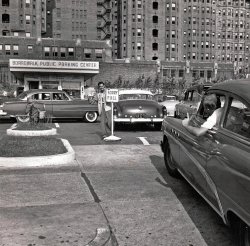
- Indy Imperial: 1904
- Indianapolis, Indiana, circa 1904. "Imperial Hotel." Whose architectural style might be described as Romanesque Rococo ... a Streetcar Strange that the Imperial, a substantial hotel, wasn't located on a streetcar line, at least initially. But then we ... Posted by Dave - 08/01/2012 - 1:41pm -
![Indy Imperial: 1904 Indianapolis, Indiana, circa 1904. "Imperial Hotel." Whose architectural style might be described as Romanesque Rococo Curlicue Baroque, and whose slogan could be "every exterior surface embellished." Note the early automobile. 8x10 inch dry plate glass negative, Detroit Publishing Company. View full size.
"Rococo Curlicue Baroque"My new favorite architectural style!
No people!Even though the buildings are awesome, many pre-automobile era pictures show cities with no people walking around.
[I count at least five or six people here. - Dave]
All that's left is the base of the monument.View Larger Map
The detailsThe large-size version of this is great - love the detail. Some houses like these are still standing in Indianapolis (most of them a bit worse for wear after all these years).
Look in the windowsOnce you enlarge the picture it's really interesting to see the people in the windows & on the street - the guy with his dog is my favorite!
A Desire for a StreetcarStrange that the Imperial, a substantial hotel, wasn't located on a streetcar line, at least initially. But then we find that it wasn't built as a hotel at all: rather it originally housed, starting in the mid-1890s, the National Surgical Institute (click for an interesting history of the curlicue colossus).
The fancy ironwork up top wasn't just for show; patients and visitors to the institute were allowed to stroll on the roof, presumably to take in the surrounding sights and the rarefied air.
Modern BlandnessThe Imperial Hotel has long-since vanished. The spot is currently occupied by a parking lot. I think the Imperial was demolished long before that, however. The area was a run-down district full of pawn shops and billard halls and taverns prior to construction of a 37-story office tower immediately to the east.
This is the NW corner of Ohio St and Capitol Ave, near the center of the city. Immediately to the south, just out of view except for a limestone pillar, is the Indiana statehouse. Only the base of the pillar remains there today. I will do some investigation to see if I can find out what happened to it. I would guess it has been relocated to another spot on the statehouse grounds, but I don't recall seeing anything similar to it.
Indiana PictureThanks for a picture from Indianapolis and would love to see more Indiana pics, especially Lafayette, Indiana, if you have then. Thanks again!
Imperial Hotel (aka National Surgical Institute)Formerly the National Surgical Institute, the hotel stood at the northwest corner of Capitol Avenue and Ohio Street.
In January 1892 the old home of the National Surgical Institute burned and 19 patients were killed. This building was built following that disaster as the new home of the hospital. The Institute soon went bankrupt and by 1898 the building housed the Medical College of Indiana. By 1901 this institution had also vacated the building and the current tenant was the Imperial Hotel. Now a parking lot.
View Larger Map
Cheat SheetsYou may ask yourself "what's holding up those balconies?" Well, not much. I've found that an awful lot of what passes for carved stone in these old buildings, in particular the elaborate cornices, were in fact pressed sheet metal. Sheet metal rusts, and that's why a lot of old buildings lost their cornices by the 1940's - they got rusty and unsafe.
Really neat light bulbDon't you just love that light bulb in the picture? Bet you don't find many of those around any more.
[What looks like a big light bulb is the globe of a carbon arc lamp. - Dave]
Wrteched ExcessWhat a grand building; very democratic: something for everyone! No style too unimportant to include. It's a shame it's gone. Maybe this is what Carole King had in mind when she wrote that song?
Architectural horrors!Someone accidentally dropped the blueprint in a blender or possibly there was an explosion at the brick factory, or both. That's all I can think of.
WoofYes, Dave, there are people in the shot. And a frisky doggie, too.
Rapunzel in the cityThis lady made me think of Rapunzel, all alone in the far tower of her curlicue castle/hotel. Perhaps the man opening the window below is her prince.
What a melting potof ideas and designs we're seeing lately here at Shorpy. I'm fascinated by the influences and styles that a growing USA built in these formative decades.
More please Sir.
Doorway to the futureWhat's with that strange entrance on the left? It looks like a sheet of plywood with a doorway and diamond-shaped window cut out. That's a bad 1950s remodel, in 1904.
Magnificent EmbellishmentsI am imagining just a few years earlier, little Georgie Amberson Mainifer tearing around the corner in his pony cart. It appears that Georgie and the National Surgical Institute both got their comeuppance.
Now I am off the the library to pick up an armload of Booth Tarkington.
Early automobileDoes anyone know what that "early automobile" is?
I don't even see where the engine is.
Dingy medicine!All that's left of the "National Surgical Institute" is Dr. Caldwell's Clinic/Sanitarium in the basement. Great for "electric treatment" and "facials." Must have been so incredibly dark and creepy down there too.
A Textbook Exampleof Romanesque Rococo Curlicue Baroque if I've ever seen one!
A shocking treatment regimen"Dr. Caldwell's Institute" in the basement offers "Water and Electrical Treatment".
Not simultaneously, one hopes.
A hotel with an "institute"A hotel with an "institute" (and sanitarium? Guy is blocking that window) in the basement. Classy place!
Feel like zooming in on any of those basement windows? It looks like one of them is advertising a "massage" but perhaps my imagination is being overactive.
[From left to right, the windows say ... - Dave]
DR CALDWELL'S INSTITUTE
Waiting Room
Treats diseases of Skin, Blood & Nerves
FACIAL TREATMENT
By Electric Massage
NEW PROCESS.
[Illegible]
HOMEOPATH
OSTEOPATH
WATER and ELECTRICAL TREATMENT
Every form.
Entrance on Cap. Ave.
CALDWELL'S SANITARIUM
and
[Medical?] Institute
MECHANICAL and MANUAL
MASSAGE
and
[Something] BATHS
ELECTRO-HYDROPATHIC INSTITUTE
A little more historySadly, this whimsical building was demolished in the late 1940s for a parking lot. It was built as the National Surgical Institute in the mid 1890s, but quickly went bankrupt. After serving as a medical school for a short time, it was converted into a hotel. The name changed from Imperial Hotel, to Hotel Metropole in the 'teens, and finally Hotel Roosevelt. By 1949 the site was called the Roosevelt Car Park.
More photographs in an article I wrote for Historic Indianapolis are at this link.
(The Gallery, Cars, Trucks, Buses, DPC, Indianapolis)](https://www.shorpy.com/files/images/4a11598a.thumbnail.jpg)
- Lafayette Square: 1905
- ... next to a fire hydrant is illegal!
The Lafayette Hotel in the center of the shot in currently undergoing a $35M-$40M ... will result in one and two bedroom apartments and up to 50 hotel rooms, as well as several businesses on the ground floor. The exterior ... Posted by Dave - 07/22/2012 - 10:42am -
![Lafayette Square: 1905 Buffalo, New York, circa 1905. "Lafayette Square." 8x10 inch dry plate glass negative, Detroit Publishing Company. View full size.
You can't park that here! Parking next to a fire hydrant is illegal!
The Lafayette Hotelin the center of the shot in currently undergoing a $35M-$40M renovation that will result in one and two bedroom apartments and up to 50 hotel rooms, as well as several businesses on the ground floor. The exterior and much of the interior are being painstakingly restored to their original appearance. Target date for completion is May 1.
Three dimensionalThe depth of field and scope of the lens have created one of the coolest looking images yet seen. Great job of scanning to maintain the effect. I feel like I'm looking out a window onto the actual scene.
Your policy has expiredI had no intention of commenting until something struck me as humorous in the building on the right hand side. I would bet that the New York "Life Insurance" company did not appreciate one of their employees perching himself in an open fourth story window.
Plus 107and the bystanders are less ghostly and considerably less well-dressed.
View Larger Map
Good to seeThat at least two of the major buildings has survived. What was that glorious masonry gem on the far side of the Square?
[The Buffalo Public Library, dedicated 1887, demolished 1963.]
Shame
What Is It?OK, I have to ask this. Sure, I have only been on Shorpy about 3 months, but have traveled all over Europe and seen these http://www.urinal.net/pissar/
But I have never seen them in old photos such as here.
Is this a pissoir? Something for the horse buggies? Fresh water? Something for the drivers to "dispose" certain things of?
[Whatever it is, it has an electrical connection to the streetcar grid. - Dave]
*MrK replying*
I see that Dave, thanks! Missed it the first time. Also, looking at the shadow, the object looks like it does not have the same dimentions all around. Looks wide, but not deep according to the shadow.
The photo here on the page is a little too low res to discern where the wire goes or what it is connected to (Dave can you help?). I see what appears to be a fire call box on the furthest trolley pole in that block corner.
I will ask a few trolley experts here about it and hope to report back :)
Not a lot of automobiles yetbut a year later, on July 4 1906, Buffalo would record its first instance of a pedestrian being fatally mowed down by one of the infernal machines when Henry A Ward, founder of Ward's Natural Science Establishment (and taxidermist of Jumbo the Elephant mount fame) succumbed.
re: The TardisIf it is connected by wire, then so are the horses or the coachman standing close by.
No, I think the wire simply is passing above, to support another segment of the trolley cable running overhead.
[You're looking at the wrong wire. - Dave]
Formerly Courthouse SquareThis location was renamed to commemorate the Marquis de LaFayette's visit to Buffalo in 1825, the same year the Erie Canal was completed. This location is just a few blocks north of the Ellicott Square Building, designed by Daniel Burnham and opened in 1896 (the world's largest office building at the time). The Ellicott Square Building was featured on Shorpy a while back: https://www.shorpy.com/node/10750
Big GunThe large cannon at left center is a Civil War-era Parrott Rifle, named after its designer Robert Parker Parrott. These were cutting edge when introduced in 1861 and came in variety of sizes. Both the Army and Navy used them up through the early 1890s.
This particular Parrott seems to be a big one, possibly a 200 pounder, meaning it could fire a pointed shell weighing 200 pounds.
Military technology moved swiftly in the late 19th century and Parrotts were phased out as more modern artillery came into use. Many obsolete Parrotts and other Civil War cannon ended up as martial ornaments in city parks and military cemeteries.
The scrap drives of World War II took a huge toll on ornamental cannon. Wonder if this Parrott survived?
The Tardis-identity revealedThis is a police call box. Very common at the time. I've attached a picture of a rather more ornate one, but of the same general layout. I think the wire DOES go to the box, for the telephone inside.
The Tardis-identity revealedVery nice find. Makes sense now, following that wire to the fire pull box with this police call box makes sense to bundle the wires and be routed back to the same place.
Darn that Chameleon circuit, looks like it will never get fixed!
KleinhansI wonder if Kleinhans wouldn't sell their building, so they built the U-shaped New York Life building around it?
[That's an integral part of the Brisbane Building, constructed 1894-1896. The previous structure, The Arcade, was completely destroyed by fire in 1893.]
Buffalo Tardis: real identity revealedNot a call box, although many had telephone connections in a box OUTSIDE this "booth". These were used by walking patrolmen as one-man jails. A rowdy would be stuffed inside, locked up, and the paddy wagon sent for. They were at various intersections all over Buffalo, until about 1940. See photo and caption here.
Hotel LafayetteHere's an update to the previous post about the rehabilitation of the Hotel Lafayette.
I appreciate that their original 1905 sign indicated that the hotel is "Fire Proof". Sleep in safety!
As a side note, the hotel was designed an built by the first accredited female architect in the AIA, Louise Blanchard Bethune.
QuestionsTwo questions.
Where is the smoke coming from? It looks to be a warm summer day, so it wouldn't be from furnaces in the buildings. It seems to originate on top of the building between the Hotel LaFayette, and Kleinhans. Or, is it some kind of smudge on the photo plate?
[Buffalo was an industrial center with many factories as well as coal-fired locomotives and steamships. - Dave]
And, did no one ride horses in the city? Or, did no one ride horses downtown? I don't see any riders in any downtown photos, and I don't see where you'd tie one up. All I see s carriages and cars and streetcars.
[City folk didn't ride horses like they were bicycles. They took the streetcar or sidewalk (or biked) to get where they were going. - Dave]
If you go to Buffalo, do check out the renovated Hotel LaFayette. Its gorgeous!
(The Gallery, Buffalo NY, DPC, Horses, Streetcars)](https://www.shorpy.com/files/images/SHORPY_4a17410a.thumbnail.jpg)
- Hotel Cadillac: 1906
- Detroit circa 1906. "Hotel Cadillac, Washington Boulevard." 8x10 inch dry plate glass negative, ... can make out the middle word in the inscription.
["Hotel Scotten Cadillac," for Daniel Scotten, who built the hotel in 1888.]
Thanks to 'Savonarola' I just spent 5 ... Posted by Dave - 07/19/2012 - 10:19pm -
![Hotel Cadillac: 1906 Detroit circa 1906. "Hotel Cadillac, Washington Boulevard." 8x10 inch dry plate glass negative, Detroit Publishing Company. View full size.
Double VenteThat lady by the barber shop entrance has certainly got a big cuppa Starbucks.
Step right downstairsUh oh, there is one of those barber poles in the center. Who is next? Do you need a haircut, tooth pulled or a bleeding? Ha! Now the barber isn't even allowed to shave the back of your neck.
A room upgrade A room upgrade to whomever can make out the middle word in the inscription.
["Hotel Scotten Cadillac," for Daniel Scotten, who built the hotel in 1888.]
Thanks to 'Savonarola'I just spent 5 enjoyable minutes searching for and finding that inscription. I love Shorpy!
(The Gallery, Detroit Photos, DPC)](https://www.shorpy.com/files/images/SHORPY_4a07040a.thumbnail.jpg)
- Astoria, Oregon: 1944
- ... in the middle of the street is killing me!
Commodore Hotel If you'll be my Dixie Chicken, I'll be your Tennessee Lamb --
... Red ... and you didn't even need to stop.
Commodore Hotel The Commodore Hotel is still going strong. It was a nice boutique ... Posted by Dave - 03/24/2021 - 10:54am -
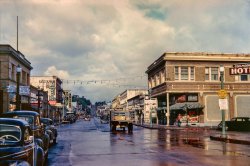
- Yardmaster Tyres: 1943
- ...
No furniture? They moved it all down to Brown's Hotel, where lots of them people have been travellin' for quite a spell.
Oh ... Posted by Dave - 07/28/2024 - 5:14pm -

- Hotel Winston: 1913
- Washington, D.C., 1913. "Winston Hotel car." Parked, it would seem, in front of the Hotel Winston, First Street and Pennsylvania Avenue N.W. View full size.
... put the fire escape smack dab in the front of your nice hotel, might as well try and make it look nice. I presume the, what was that ... Posted by Dave - 10/08/2014 - 1:23pm -
